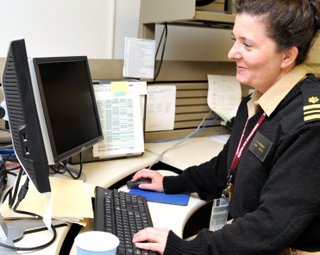The Next Chapter in Bio-Readiness

I am pleased to report that we opened a first-of-its kind biosurveillance center today that gives the nation the ability to see fast-moving, potential health threats in a new way – before it’s too late.
Patterns in illnesses usually are only seen after enough people get sick or die to sound alarms. Investigators then retrace the steps of the victims to determine the source of trouble, but it’s often too late for those who have already been unknowingly exposed.
Whether it’s food contaminated with Salmonella, the first waves of illness from a pandemic flu, or an anthrax attack by terrorists, spotting biological threats sooner means that thousands of lives might be saved.
Traditional methods of detecting such threats often take too long. Our National Biosurveillance Integration Center (NBIC) will change that.
The center will combine all sorts of information – from classified material shared in a secure environment, to transportation and border data, to local media reports – so that events around the country and the world can be connected and analyzed more closely and quickly, and threats bubbling up can be detected earlier than ever before.
This 24-hour operation brings together experts from some agencies that may be obvious. The Centers for Disease Control and Prevention and the Food and Drug Administration, for instance, both monitor health patterns. And the Departments of Agriculture, State and Commerce all play critical roles in preventing the global spread of avian flu or Foot-and-Mouth disease while protecting the nation’s economy.
But there is more to the center than a collection of agency representatives.
Through the center’s secure computer network, DHS has now created a whole new level of daily cooperation among private sector partners, health officials and government agencies who now all work together to hunt for early signs of trouble.
The center is developing a clearer picture of what typical health patterns look like so that even a small blip can be investigated before large clusters of people get sick.
Being able to identify emerging threats earlier was one of the key recommendations from the 9/11 Commission. As the Japanese learned in 1995 when the Aum Shinrikyo religious sect released sarin nerve gas on subway lines killing 12 and injuring 5,500, biological attacks are a modern global reality.
Our new surveillance builds on another one of our programs, BioWatch, an environmental early detection program which uses monitors in over 30 urban areas to sniff the air for biological threats.
Dr. Jon R. Krohmer
Acting Assistant Secretary/Chief Medical Officer
Labels: biodefense, information sharing, Office of Health Affairs, risk


2 Comments:
You mention cooperation with all all relevant organizations and access to classified material, but how well integrated will this Center be with current military and intelligence community efforts, as well as emerging private sector initiatives such as Google.org's Predict and Prevent?
With current security clearance backlogs, is this new effort already staffed with cleared personnel that also have appropriate subject matter backgrounds?
Thanks.
By Arnold, At
September 30, 2008 6:15 PM
Arnold, At
September 30, 2008 6:15 PM
Soooo boring...
By Jeff O, At
September 30, 2008 9:32 PM
Jeff O, At
September 30, 2008 9:32 PM
Post a Comment
Create a Link
<< Home